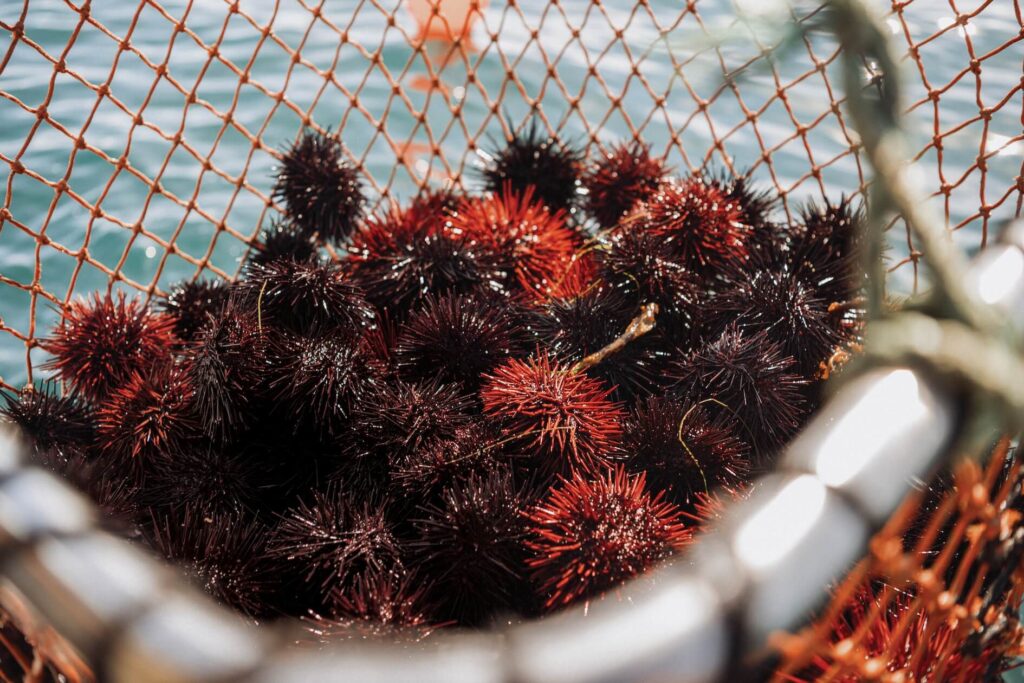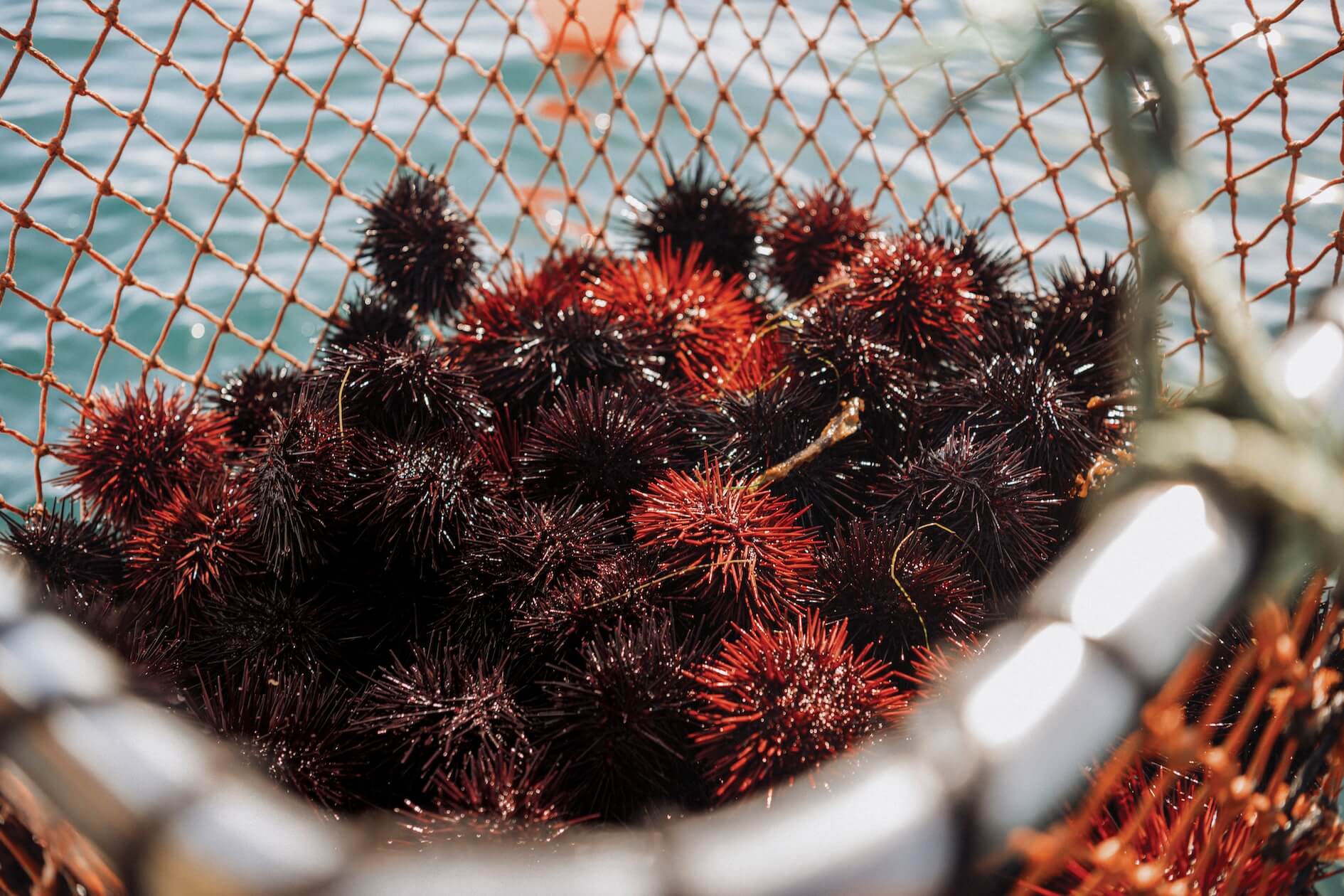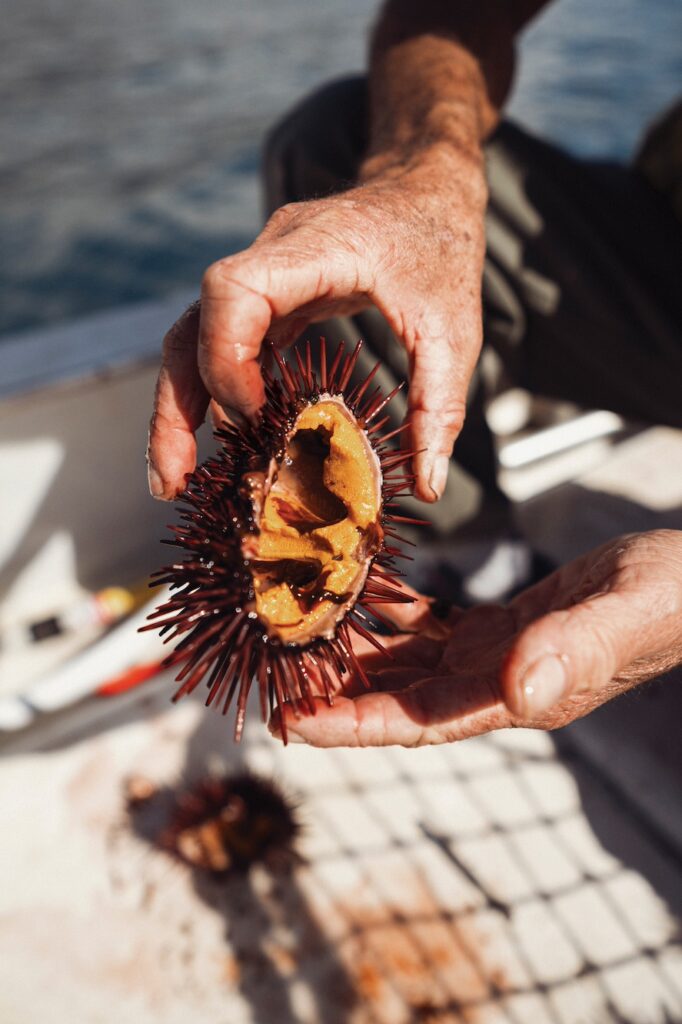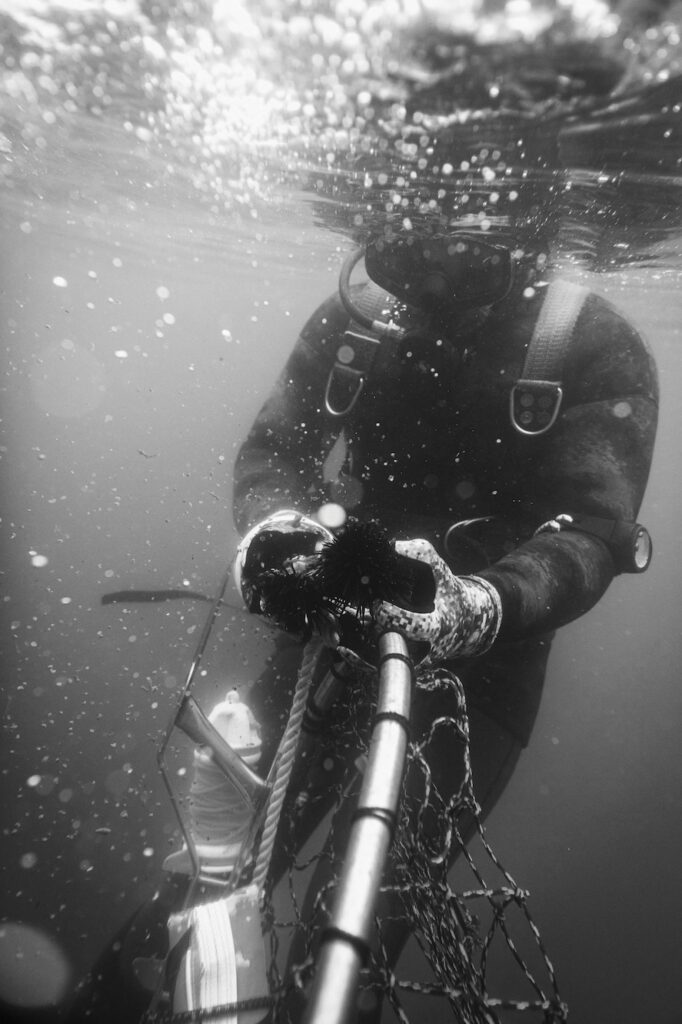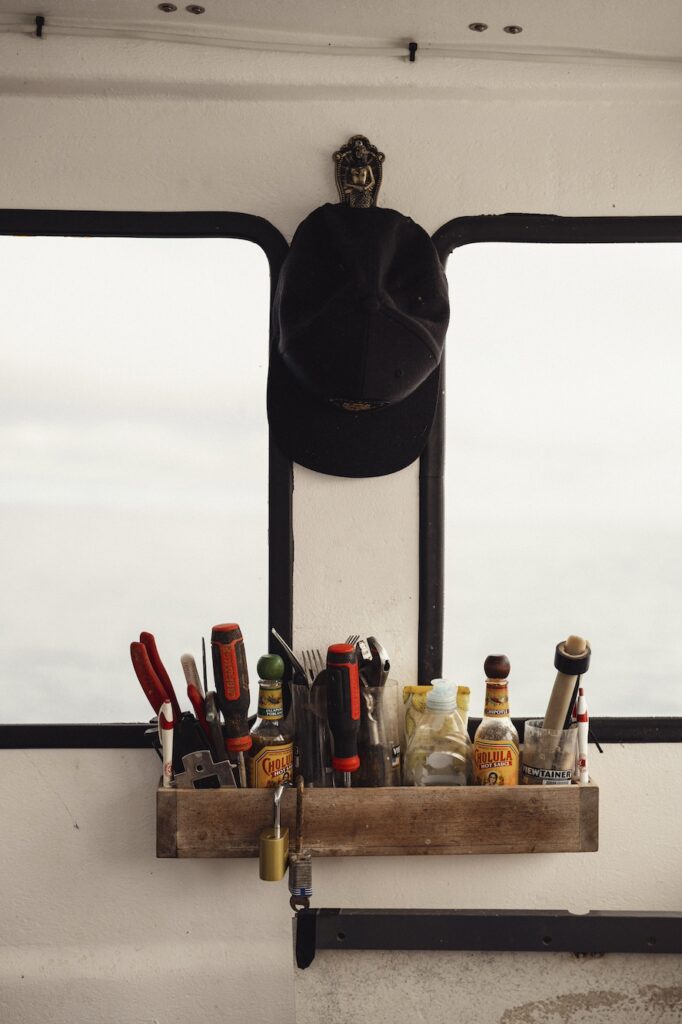It’s still dark when John Hoadley sets out to go treasure hunting in the Channel Islands off Santa Barbara. The 40-year-old diver’s 32-foot lobster boat is newly christened Sol Rising, after his daughter, Soleil, but its captain is more veteran than newbie: For the past two decades, Hoadley has been corralling spiny lobsters, shy sea cucumbers, and, his primary catch, the world-famous Santa Barbara red sea urchins.
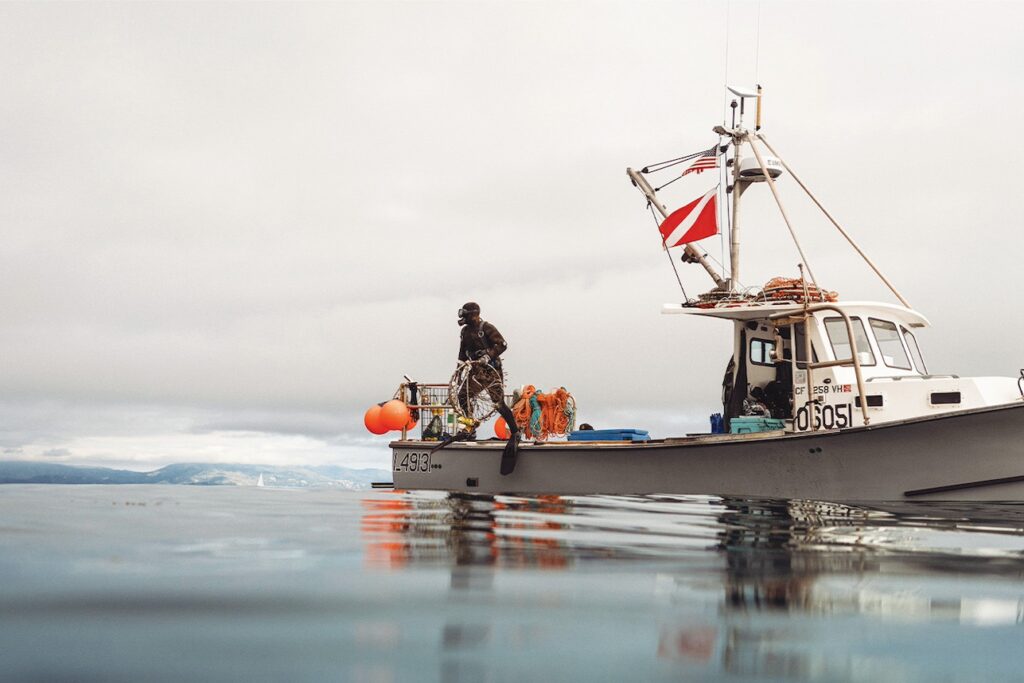
A couple hours after departing from the wharf, the second-generation diver drops anchor, straps on his gear, and plunges into the Pacific. Following in the flippers of his father, an avid amateur diver, Hoadley’s been ranging these waters since he was five years old.
Though the underwater terrain is as familiar as walking around his house, each hunt still makes him prickle with anticipation.
John Hoadley prepares to dive off his boat, Sol Rising, in search of delicate, delicious sea urchin.

Since late 2013, when an intractable mass of warm water began to emerge off the California coast—locals sometimes call the phenomenon The Blob—this prize product has become less plentiful and thus, more precious. Now, fishers and divers are retooling, changing their games to keep pace with the elements in their hunt for these delectable prey.

As Hoadley explains, “All up and down the West Coast of the United States, The Blob did a number on kelp forests,” the food of choice for red urchin world. Hoadley pivoted his business to sell his urchins directly to consumers and restaurants. Chefs and their customers don’t seem to have a price ceiling when it comes to the primal experience of consuming this oceanic, multifaceted umami.
Take Chef Brad Matthews, who gets his urchin delivery right as dinner service is getting underway at his Iberian-accented restaurant, Bar Le Côte, in Los Olivos (sister restaurant to the MICHELIN-starred Bell’s in Los Alamos), just a few short blocks away from The Inn at Mattei’s Tavern, Auberge Resorts Collection, an iconic Santa Ynez Valley property reborn last year. “You walk right through the front door,” he tells his urchin dealer, Stephanie Mutz, waders and all. “I want people smelling that blast of fresh seawater.”


Heads swivel in the white-and-emerald dining room, jaws agape and full of marinated boquerones and crab potpie, to watch the bin of spiny echinoderms approach the kitchen. “It’s a spectacle,” says Matthews, who typically orders 50 urchins a week and double that in the summer, when he sets the uni over lush creamed corn with shrimp and basil. Mostly, though, he prefers serving them like oysters, simply shucked and raw over ice.
The uni at Bar Le Côte, served unadulterated over ice, “a beautiful glimpse of what the ocean has to offer.”

“Sea urchin is so special from this area—Santa Barbara,” says Mutz, picking through a basket of a recent catch while her boat is parked in its slip in the city’s marina. “The flavor is so complex. It evolves in your mouth. In one bite, you get sweet, you get salty, you get umami, then you get sweet again. It’s like an adventure. It doesn’t taste like anything else. When people ask me what it tastes like I say sweet ocean with an avocado or custard texture—that’s as close as I can come.”
“The other reason,” she continues, explaining Santa Barbara uni’s exalted status, “it’s a delicacy.”
That fact has revealed itself vividly over the last several years.


Matthews and his customers by the Santa Barbara Channel are lucky enough to feast on red urchins with “lobes as large as a wristwatch.” This is decidedly not the case in other parts north on the coast, where harvesters have come to depend on purple urchins that can be as small as quarters, according to second-generation diver Grant Downie, who dives near Fort Bragg north of San Francisco.
Chef Brad Matthews of Bar Le Côte.
Unlike in the Santa Barbara Channel, where the native macro kelp that urchins feed on can tolerate warm water, the sensitive bull kelp in other areas have been decimated since The Blob. In a cascading disaster, the sunflower sea star population was also at risk. The sea star is the main predator of the purple urchin, and in their absence, the latter proliferated.

The purps, as they’re sometimes called, can survive on so little food that they also go by the nickname zombie urchins. The cycle has been a vicious one, with the purps devouring remaining kelp that used to feed their red counterparts, ensuring their dominance. The purple urchins are edible, but nowhere near comparable to the sweet and creamy flavor of their crimson cousins—so-called “sea butter,” as Anthony Bourdain once famously described them.
Red or purple, education is key; even though urchins have been a part of this landscape for millennia longer than humans, some diners still see them as aquatic enigmas, and may, upon first glance, look at them with a mix of intimidation and curiosity. “What am I going to do with that?” is a question often asked.

Rhoda Magbitang, executive chef at the Inn at Mattei’s Tavern, gets that one a lot, which is why the chef spearheaded the immersive Art of Uni experience at the storied hotel. “It’s not like teaching people how to peel a shrimp, so it felt kind of like a crazy idea at the time,” says Magbitang. “You don’t know what people are going [to] be like when they arrive; could they be squeamish? Could they be like, ‘What did I get myself into?’”


Her apprehensions proved unfounded. The guests learn how to break down the urchin and delicately excise their gold. Magbitang encourages them to taste the uni au naturel, then in a pairing with champagne and chardonnay, before demoing three outrageous dishes: fried oysters with uni, smoked Okinawan sweet potato with black garlic and uni, and uni toast with bacon jam and translucent veil of torched lardo. “Utilizing uni in pasta and risotto is wonderful, but I think there’s just so much more [you can create with it],” Magbitang adds.
Chef Rhoda Magbitang’s Art of Uni experience at The Inn at Mattei’s Tavern, which features the delicacy prepared in three distinct and delicious ways, including uni toast with bacon jam and a translucent veil of torched lardo.
Obviously, it’s no surprise guests love the food and wine, but Magbitang did not expect them to love the prep work. “I think the most surprising takeaway is how much they enjoy the process of cleaning the urchins,” she says. “People get into it. Some of them ask for seconds.”
